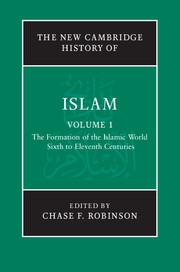Book contents
- Frontmatter
- Introduction
- PART I THE LATE ANTIQUE CONTEXT
- PART II UNIVERSALISM AND IMPERIALISM
- PART III REGIONALISM
- 10 Arabia
- 11 The Islamic east
- 12 Syria
- 13 Egypt
- 14 The Iberian Peninsula and North Africa
- PART IV THE HISTORIOGRAPHY OF EARLY ISLAMIC HISTORY
- Conclusion: From formative Islam to classical Islam
- Glossary
- Bibliography
- Index
- Plate Section
- References
13 - Egypt
from PART III - REGIONALISM
Published online by Cambridge University Press: 28 March 2011
- Frontmatter
- Introduction
- PART I THE LATE ANTIQUE CONTEXT
- PART II UNIVERSALISM AND IMPERIALISM
- PART III REGIONALISM
- 10 Arabia
- 11 The Islamic east
- 12 Syria
- 13 Egypt
- 14 The Iberian Peninsula and North Africa
- PART IV THE HISTORIOGRAPHY OF EARLY ISLAMIC HISTORY
- Conclusion: From formative Islam to classical Islam
- Glossary
- Bibliography
- Index
- Plate Section
- References
Summary
Muslims and Christians
In Egypt the Arab conquest initiated a cultural transformation that left unchanged the constants of the country’s history over the past three thousand years. The country itself was an anomaly, a vast oasis formed in the desert by the Valley and Delta of the Nile, a great tropical river bringing an immense amount of water to a rainless land. From the first cataract at Aswan to the sea, it made possible irrigated agriculture on a grand scale, a large agricultural population and a centralised state. To the north, the Delta or Lower Egypt looked to the Mediterranean and Near East; to the south, the Valley or Upper Egypt looked to Nubia, the Red Sea and the Indian Ocean. The arc became a full circle with Islam, which added the western and central Sudan, and a systematic relationship with North Africa. Politically, the state had the resources to expand north-eastwards into Syria, westwards to (modern) Cyrenaica in Libya and southwards into Nubia, but the country was equally open to invasion and conquest, so that for the past fifteen hundred years it had alternated between the status of a province and a seat of empire ruled by immigrants. The history of the first four hundred years of Muslim rule is the history of its further progress from province to empire under the impulsion of fresh waves of conquest. The novel feature was the accompanying passage from Christianity, Coptic and Greek to Islam and Arabic.
Keywords
- Type
- Chapter
- Information
- The New Cambridge History of Islam , pp. 541 - 580Publisher: Cambridge University PressPrint publication year: 2010
References
- 2
- Cited by

